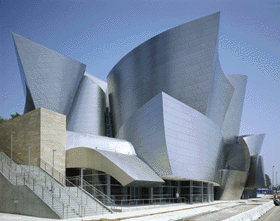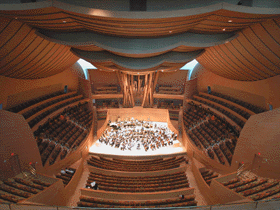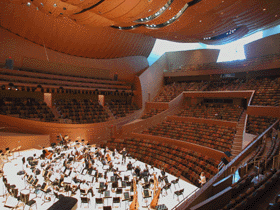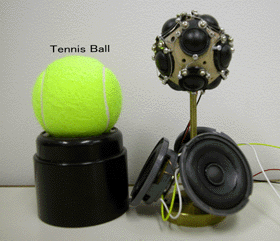
Title means "Quietness", "Comfortable Sound" and "Excellent Acoustics"
Nagata Acoustics News 03-12 (No.192)
Issued : December 25, 2003
Walt Disney Concert Hall Opens!
by Yasuhisa Toyota
Exterior of WDCH
(photo by LA Philharmonic)
 |
Los Angeles' Walt Disney Concert Hall opened on October 23, 2003. The hall is the new home of the Los Angeles Philharmonic Orchestra and is designed specifically for the performance of classical music.
Nagata Acoustics served as the acoustical consulting firm on the project. The hall's opening marks Nagata Acoustics completion of our first major concert hall project outside Japan.
The new Walt Disney Concert Hall is located in the middle of downtown Los Angeles, directly across the street from Dorothy Chandler Pavilion, where the Los Angeles Philharmonic used to perform its subscription concerts. L.A.-based, internationally renowned architect Frank O. Gehry designed the Walt Disney Concert Hall's eye-catching architectural design, which is already attracting crowds of tourists and being hailed as a new Los Angeles landmark. The Los Angeles Philharmonic's web page about "WDCH" is http://wdch.laphil.com/about/overview.cfm.
<< Opening Galas, Preview Rehearsals and Media Attention >>
Inside the Walt Disney Hall building, the concert hall clearly plays the starring role among the structure's facilities and is the focus of the hall's inaugural season schedule. For three days beginning October 23, 2003, the Los Angeles Philharmonic performed three Opening Galas, each with a different program, under the baton of its Music Director, Esa-Pekka Salonen. Thereafter, the hall's calendar featured a succession of two-months' worth of enticing concert programs centered around the Los Angeles Philharmonic's subscription series. Among the noteworthy visiting performances was Simon Rattle conducting the Berlin Philharmonic Orchestra.
Even before the hall's official opening, selected audiences were invited to attend some 10 pre-opening preview sessions during rehearsals in the hall. The invitees to these previews included representatives from the press corps who responded by reporting on the hall and, in particular, its acoustical performance, creating quite an advance "buzz" in newspapers, magazines and other publications. During the two weeks immediately before and after the hall's opening, the local print media, starting with the Los Angeles Times, devoted an incredible amount of coverage to Walt Disney Concert Hall, with nearly an article a day, or more, about the hall and its acoustics. Many of the articles filled entire pages of the newspaper.
Since all of my previous experiences of hall openings were in Japan, the extent of media attention lavished on the Walt Disney Concert Hall opening amazed me. Perhaps the media's huge interest in the hall's opening demonstrates how deeply rooted classical music, the arts and culture, in general, are in the daily life of the people and society. Or maybe the media's plentiful coverage simply reflects its recognition of the large population of subscription concert ticket holders and the large number of subscription performance concerts scheduled for these patrons (and readers) to attend (numbers that are almost mind-boggling compared with Japan's statistics.)
<< Praise for Walt Disney Concert Hall's Acoustics >>
If I were to write here that the opinions voiced by the media and others about the new hall's acoustical performance have been unswervingly positive, I would not quite be presenting the situation accurately. Rather, the hall's acoustics have been showered, perhaps deluged is a more appropriate word, with an incredible outpouring of praise and commendation, making the normally sedate topic of acoustical performance sensational news. Personally, my first reaction was to experience a huge sigh of relief.
Music Director Esa-Pekka Salonen told me that he was "100% delighted" with the acoustics and most of the orchestra's members were favorably impressed with the new hall's acoustics from their very first rehearsal in their new home. After Simon Rattle performed in the hall with the Berlin Philharmonic Orchestra, and it was time for him to take his leave of the hall, he told me "Thank you for giving music the best present ever."
<< The Twists and Turns of the Hall Construction Project's Life Cycle >>
Nagata Acoustics completed our acoustical design and consulting work on the Suntory Hall project 17 years ago, in 1986, when that hall opened in Tokyo. In the following year (1987), Walt Disney's widow, the late Lillian Disney, made a gift of $50 million to the people of Los Angeles County for the construction of a music performance center. Her gift initiated the Walt Disney Concert Hall project.
During the next year, 1988, the project's architect and acoustical design consultant were selected. As part of the selection process, a Hall Construction Committee that included the Los Angeles Philharmonic's Executive Director and other key stakeholder representatives toured Suntory Hall and other venues around the world. The committee then held an international competition to select the acoustical design consultant and Nagata Acoustics was one of the acoustical consulting firms invited by the committee to submit a proposal. Nagata Acoustics won this competition and we began our design work the following year (1989).
This project's entire duration, from the start of our design activities in 1989 to its completion in 2003, actually lasted 14 years. One complication occurred because of economic impacts during the first half of the 1990s, when the U.S. economy experienced a downturn that forced the entire project to come to a halt for a nearly four-year period, from 1994 to 1998.
When we first began our design work for Walt Disney Concert Hall, most people in Japan who heard about our participation in the project did not have a clue about what kind of project this was. Nor was it easy for us to overcome some preconceived assumptions about what the project might be, since the Disney name made some people ask if we were designing a hall that would be built for shows at Disneyland. We explained repeatedly that the hall bears the name "Walt Disney" to honor the memory of Walt Disney and because the vision to build the hall began with his late widow, Lillian Disney, and her desire to pay tribute to her husband's memory with a most generous gift for this purpose. We repeatedly pointed out that the completed hall belongs to Los Angeles County, making it truly a publicly owned hall. We also consider it significant to mention that as the Music Center for the County of Los Angeles, the hall is exclusively consigned for use by its resident orchestra, the Los Angeles Philharmonic.
<< Overview of the Concert Hall Building -- from the Outside >>
Everyone who sees the Walt Disney Concert Hall building's design, by architect Frank Gehry, immediately recognizes it as something unique. An exterior skin of stainless steel covers the entire structure in undulating, three-dimensionally curved surfaces. The impression of the whole is more that of a sculpture than of a building.
The Walt Disney Concert Hall complex stands on a 3.6-acre site (14,569 sq. m.). The total floor area of the concert hall building is 293,000 sq. ft (27 sq. m.). The total cost of the project (design + construction costs) was US$274 million.
<< Inside the Concert Hall Building >>
Interior of WDCH
 |
While the 2,265-seat hall for classical music concerts is clearly the focal point of the Walt Disney Hall building, the structure also has a spacious entrance lobby and foyer (as well as a small shop and a restaurant) and a full complement of backstage dressing room facilities. Practice room facilities include 13 ensemble rehearsal rooms of various sizes and one rehearsal room designed for choral practice.
In the concert hall's lobby, an appropriate space where 200-300 people can gather has been designated the Pre-concert Area. Here, during the half hour before each subscription concert, the Los Angeles Philharmonic holds pre-concert lectures about the concert's program. Anyone who arrives at the hall early is welcome to attend. The Pre-concert Area is designed as a convenient and versatile, multipurpose space that can equally be used for a performance of chamber music or, by adding tables and chairs, for a special dinner party.
Below the concert hall building, the underground garage provides six levels of parking. In Los Angeles, where cars are a way of life, the large-scale parking facility, which can accommodate some 2,500 vehicles, matches the lifestyle of the hall's patrons. The garage was constructed by the City of Los Angeles, using separate funds and in a separate project from the Walt Disney Concert Hall project.
<< Overview of the Walt Disney Concert Hall Interior >>
Interior of WDCH
 |
The concert hall seats 2, 265. Compared with Tokyo's Suntory Hall (2,006 seats), Walt Disney Concert Hall is an order of magnitude larger. The hall configuration is fundamentally the same for both halls, a shape known as the vineyard layout.
The decision to implement a vineyard configuration preceded the competition to select the hall's acoustical designer. Specifying the vineyard configuration was the wise choice of the Hall Construction Committee, whose members had traveled and listened to concert halls around the world to help them reach their decision.
In a vineyard configuration hall, the audience seating area is divided into blocks of seats, and each block is placed at a specific height, in stepped relation to the other blocks of seats in the hall. The different heights of the blocks of seating create multiple, low, side walls around the hall and these surfaces are used in the hall's room acoustical design to obtain the time-delayed, small, early sound reflections that are essential to the sound in the audience seating areas. The Berlin Philharmonic Hall was the first concert hall to adopt the fundamental acoustical design approach of the vineyard configuration.
The hall's interior makes abundant use of solid wood. The ceiling and walls are paneled with Douglas fir, the floor of the stage is Alaskan yellow cedar and the floor of the audience seating areas is oak. Behind the wood paneling of both the walls and the ceiling, we sprayed a layer of shotcrete so that the walls and ceilings would have the weight necessary to produce low register sound reflections. In addition, at my request the ceiling's architectural design includes small peaks and valleys, which I added to promote diffusion of high register sound reflections.
Post-completion evaluations obtained reverberation time measurements of 2.2 seconds for the unoccupied hall (at 500Hz) and 2.0 seconds when all seats are occupied (also at 500 Hz). The hall's spatial volume is 30,600 cu. m. (1,080,629 cu. ft), which translates to approximately 13.5 cu. m. (477 cu. ft) per seat, a rather generous per-seat spatial volume. The spatial volume and its ratio to the number of seats contribute greatly to minimizing the difference between the reverberation times of the occupied and unoccupied hall. While listening to live rehearsals and concerts in the hall, I experientially confirmed the smallness of the difference between empty- and full-hall reverberation times, and many of the musicians who perform in the hall remark about this as well.
<< Much More to Tell >>
There is so much more about this project that I wish to share, and even feel compelled to share, and I will do so in future articles. Some of the topics I plan to cover are: differences between U.S. and Japanese hall construction projects; my collaboration with architect Frank Gehry; the tuning sessions; and, the relationship between the hall and its resident orchestra.
At the time of this writing, two months have passed since the hall opened. An abundant schedule of programming, with a focus on the Los Angeles Philharmonic's subscription concerts, is now in full swing. (The website is: http://wdch.laphil.com/home.cfm.) At the same time, the long, future history of the hall's and orchestra's companionship has just begun.
The creation of a concert hall for a specific orchestra remains a too rare event in Japan and, prior to our work on Walt Disney Concert Hall, was a kind of project that, for the most part, was outside of Nagata Acoustics' experience. But even in the United States and Europe, the opportunity to participate in the opening of an orchestra's new home is a once-in-a-lifetime event for both the orchestra's musicians and its other employees and leadership. In this project, innumerable challenges appeared one after the other, and work that could proceed only by trial and error continued day after day. Please look forward to more of our accounts about the processes in which we participated, the things we saw and the things we learned during the Walt Disney Concert Hall project.
Our New Audio Speakers for Acoustical Scale Model Test
by Dr. Keiji Oguchi
As we have often noted in articles about room acoustics, acoustical scale model tests are one of the tools we can use to gain more precise evaluations of the acoustical properties and behavior of a room's interior design. Beginning with our use of a scale model in designing Fukushima Concert Hall (opened 1984), Nagata Acoustics has used scale-model testing as a design tool in more than 10 of our hall projects.
Compared with computer simulations, the main advantage that testing in an acoustical scale model offers is the ability to simulate sound wave phenomena. While I am aware that ongoing research aims to incorporate wave phenomena enhancements into computer-based modeling, from a practical perspective, the day is not yet at hand for scale-model testing to be able to be supplanted by computer simulation technology.
<< How an Acoustical Scale-model Test Works >>
The reduction scale we use for acoustical scale models of a room interior ranges from 1/50 to 1/10 of the room's actual size. During testing, in order to simulate in a scale model the sound phenomena that would occur in the full-size hall, we must shorten the length of the sound waves (using Reynolds laws of similarity). In other words, we must use high frequency sounds.
For example, in a 1/10 scale model, if we want to test phenomena that would occur with 4 kHz (4,000 Hz) sound in the full-size hall, the sound that we must use in the model is 40 kHz (40,000 Hz). This 40 kHz sound that we need is an ultrasonic sound wave outside the range of human hearing.
<< Our Previous Speaker Design for Scale-model testing >>
For on-site evaluations of actual hall interiors, we use a dodecahedron loudspeaker that has a cone speaker embedded in each of its 12 sides. At frequencies of 1 kHz and below, the dodecahedron loudspeaker has almost omni-directional characteristics.
However, for scale-model testing, in the past we used tweeters to reproduce the ultrasonic sounds we needed. To make the tweeters as omni-directional as possible, we added a narrow tube to the front of each tweeter used for reproducing sound in the scale model. The problem with this approach is that the sound-reproduction efficiency became poor.
<< New High-end Headphones Provide Parts for a Solution >>
In the past, I was always on the lookout for small speaker units that could be used in our scale-model testing. With the current shift in high-end audio trends from directional to wide-range frequency reproduction, Panasonic began marketing a headphone set that boasts reproduction from 3 Hz to 100 kHz (100,000 Hz).
The headphone has 57 mm (2-1/4")-diameter cone speakers for low frequency sound reproduction and 20 mm (3/16")-diameter dome tweeters for high frequency sounds. The headphones can be easily separated into their components, and this is what we used to build the new scale-model audio speakers we are now using in our scale-model testing.
<< New Scale-model Audio Speaker Design >>
Loudspeaker for
Acoustical Scale Model Test
 |
For the high-frequency sound reproduction of our new scale-model audio speakers, we embedded 12 dome-shaped tweeters in an 50 mm (2")-diameter wood sphere, positioning the 12 tweeters in the same configuration used for the dodecahedron loudspeaker that we employ when testing in a full-size hall. For low octave sound reproduction, we used 3 cone speakers arranged in a circle.
To build the prototype of the new speaker design, we enlisted Mr. Katsuji Naniwa, of Morimoto-Naniwa Sound Planning. The prototype we are now using has exposed cords connecting the speaker units, revealing the currently hand-built, "garage shop" nature of the apparatus.
The results of our test measurements of the new scale-model audio speaker's performance in a 1/10 scale model confirmed that the speaker can reproduce sound frequencies ranging from 500 Hz to 80 kHz, with almost omni-directional characteristics for less than 10 kHz. Since building the prototype, we have already used it in a scale model built to test the acoustical room design of the Hyogo Prefecture Center for the Arts and Culture (now under construction) and we plan to use it in early 2004 when we begin scale-model testing for Copenhagen's new Danish Radio Concert Hall.
E-mail Distribution of Nagata Acoustics News & Opinions
We hope you have enjoyed this News & Opinions newsletter, available each month on our web-site (http://www.nagata.co.jp). We also offer e-mail delivery of the text version of this newsletter. To receive the text newsletter to your e-mail address, simply send the following information to us at newsmail_e@nagata.co.jp:
(1) Your e-mail address
(2) Your name
(3) The name of your company
By requesting the text version via e-mail, you will automatically receive every newsletter and you can still get the visuals and graphics at our web-site.
Nagata Acoustics News 03-12 (No.192)
Issued : December 25, 2003
Nagata Acoustics Inc.
Hongo Segawa Bldg. 3F, 2-35-10
Hongo, Bunkyo-ku, Tokyo 113-0033 Japan
Tel: +81-3-5800-2671, Fax: +81-3-5800-2672
E-mail: info@nagata.co.jp






